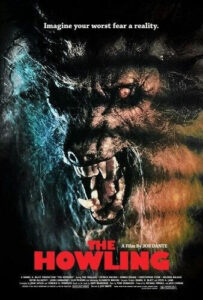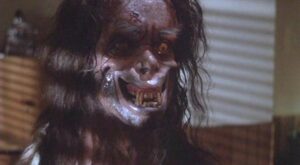The 1980s practically burst at the seams with cinematic lycanthropes, with such entries as Full Moon High, Teen Wolf, The Company of Wolves, Wolfen, and Silver Bullet. Two of the best werewolf movies to date are Joe Dante’s The Howling and John Landis’ An American Werewolf in London. The last werewolf film was released twenty years before The Howling, so what sparked this renaissance of interest in the genre? Was it a reaction against the 70s’ proliferation of New Age pomposity, or was the public simply due for another reincarnation of the werewolf? Although Dante’s film spawned some rather dubious sequels, the original will forever remain a classic, and his work with John Landis proved that this genre could be taken seriously, especially with The Howling. The screenplay by John Sayles is based on a novel by Gary Brandner, but it deviates quite a bit from the conventional horror fare of the werewolf genre.
Any such explanation of werewolves and their habits is completely unnecessary, but it was necessary for bringing the growling, ravenous creatures to cinematic life in all their furry, snarling, devouring fury and for tying together Joe Dante’s penchant for a little fantasy in his horror films (the rules pertaining to Gremlins being a prime example). Werewolves and their habits are superfluous in The Howling because the film operates on a dreamlike or nightmare-like logic, and for this film, that job was given to the very capable make-up effects artist Rob Bottin, who was brought on after Rick Baker had to drop out to work on An American Werewolf in London for Landis.
I still consider An American Werewolf in London to be my favorite werewolf movie, even though there is much debate as to which transformation is the best. Let’s start by ending a controversy that’s been going on for nearly 20 years in the enthusiast community. Yes, Rick Baker took home the Academy Award for his work on the special effects for American Werewolf in London the following year. Indeed, they are staggering in magnitude. The work done here by Rob Bottin (using inflatable airbags under a latex “skin” and a groundbreaking “hydraulic snout”) is and always will be the pinnacle of mutation effects.
While there are some similarities between the two films, they are also very different. Dante and his old pal John Landis both deal with similar themes, but in very different ways. The Howling has its share of gloomy jokes (the “burger shot” epilogue, a character reading Thomas Wolfe, and clips from The Wolf Man (1941) and a Little Red Riding Hood cartoon playing in the background), but Dante comes out on top.
By not veering from the path set out for it, remaining gritty, bleak, and haunting right up until the climax, which is both provocative and quite spectacular. After the success of Universal’s Dracula remake the year before, this was the first of a wave of similar creature features in the 1980s. It was preceded by Wolfen (1981), The Company of Wolves (1984), and Silver Bullet (1985), but it did for lycanthropy what Fright Night did for vampires in 1985; it solidified the wave Dante started with Piranha (1978), and it remains the best and scariest film of its kind to this day.
The monsters in The Howling take their sweet time transforming their way into the film, making for a more deliberate and suspenseful experience. What else would you rather be doing on a full moon if not watching this? The fun is absolutely howling!



